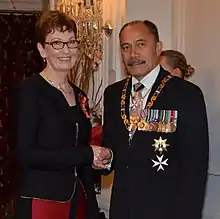Kathryn Stowell
Kathryn Mary Stowell ONZM is a New Zealand academic. She is currently a full professor at the Massey University.[1]
Kathryn Mary Stowell | |
|---|---|
 Stowell (left) with Governor-General Jerry Mateparae at Stowell's investiture into the New Zealand Order of Merit, 21 May 2015. | |
| Alma mater | Massey University |
| Scientific career | |
| Fields | Biochemistry |
| Institutions | Massey University |
| Thesis | |
Academic career
Stowell joined Massey University in 1976,[2] after a 1990 PhD titled 'Cloning and expression of the cDNA for human lactoferrin,' she rose to full professor in 2015.[3]
Stowell is best-known publicly for her work on malignant hyperthermia (MH), a genetic disorder which causes a severe and potentially fatal hypermetabolic reaction in susceptible people when exposed to inhaled anaesthetics or the muscle relaxant suxamethonium. Malignant hyperthermia has an incidence of between 1:10,000 and 1:250,000 worldwide, but 1:200 at Palmerston North Hospital due to a large family in the area carrying the gene for many generations. Stowell's work has largely concentrated on identifying the genetic basis for MH susceptibility, and developing genetic testing to replace the invasive muscle biopsy test currently used.[4][5][6][7]
In 2015, Stowell was made an Officer of the New Zealand Order of Merit (ONZM) for her services to biomedical science.[8][9][10][11]
Selected works
- Crossley, Merlin, Michael Ludwig, Kathryn M. Stowell, Piet De Vos, Klaus Olek, and George G. Brownlee. "Recovery from hemophilia B Leyden: an androgen-responsive element in the factor IX promoter." Science 257, no. 5068 (1992): 377–379.
- Rosenberg, Henry, Neil Pollock, Anja Schiemann, Terasa Bulger, and Kathryn Stowell. "Malignant hyperthermia: a review." Orphanet Journal of Rare Diseases 10, no. 1 (2015): 93.
- Davis, M., R. Brown, A. Dickson, H. Horton, D. James, N. Laing, R. Marston et al. "Malignant hyperthermia associated with exercise-induced rhabdomyolysis or congenital abnormalities and a novel RYR1 mutation in New Zealand and Australian pedigrees." British Journal of Anaesthesia 88, no. 4 (2002): 508–515.
- Stowell, K. M., T. A. Rado, W. D. Funk, and J. W. Tweedie. "Expression of cloned human lactoferrin in baby-hamster kidney cells." Biochemical Journal 276, no. Pt 2 (1991): 349.
- Brown RL; Pollock AN; Couchman KG; Hodges M; Hutchinson DO; Waaka R; Lynch P; McCarthy TV; Stowell KM (2000). "A novel ryanodine receptor mutation and genotype-phenotype correlation in a large malignant hyperthermia New Zealand Maori pedigree". Human Molecular Genetics. 9 (10): 1515–24. doi:10.1093/hmg/9.10.1515. PMID 10888602.
References
- "Prof Kathryn Stowell – Professor in Biochemistry /Biomedical Science – Massey University". Massey.ac.nz. 11 July 2017. Retrieved 23 April 2018.
- "Institute honours staff – Massey University". Massey.ac.nz. 27 March 2012. Retrieved 23 April 2018.
- "Fifteen new professors promoted – Massey University". Massey.ac.nz. Retrieved 23 April 2018.
- "The gene, the whaler, and 20 years of research – Massey University". Massey.ac.nz. Retrieved 23 April 2018.
- "New Year Honours 2015 – Citations for Officers of the New Zealand Order of Merit | Department of the Prime Minister and Cabinet". DPMC. 20 May 2015. Retrieved 23 April 2018.
- "Fighting a dangerous disorder – Massey University". Massey.ac.nz. 8 November 2016. Retrieved 23 April 2018.
- Collins, Simon (9 October 2017). "Baby's parents' warning: Anaesthetic triggered extreme reaction" – via www.nzherald.co.nz.
- "New Year Honours for Massey staff awarded – Massey University". Massey.ac.nz. 25 May 2015. Retrieved 23 April 2018.
- "New Year Honours for Massey staff and alumni – Massey University". Massey.ac.nz. Retrieved 23 April 2018.
- "Dad dies unaware daughter an ONZM". Stuff.co.nz. 31 December 2014. Retrieved 23 April 2018.
- "Associate Professor Kathryn Stowell, ONZM | The Governor-General of New Zealand". Gg.govt.nz. Retrieved 23 April 2018.
External links
- Kathryn Stowell publications indexed by Google Scholar
- Publications by Kathryn Stowell at ResearchGate